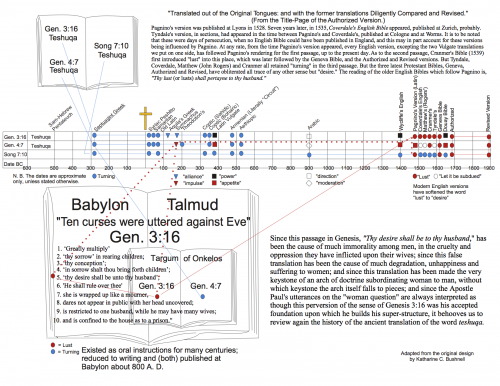Text:God's Word to Women:Lesson 19
REVIEW WITH A CHART.
145. The lesson of the mistranslation of Genesis 3:16 is so very important that we represent the false rendering of teshuqa again, by means of a Chart which will readily fix its history upon the mind.
The scale running across the middle of the Chart is cut up into centuries by perpendicular lines. All to the left of the cross is B. C. in time; to the right A. D. One space of the scale, the bottom, numbers centuries, and gives the exact date of versions, so far as known; all the other dates are merely approximate, and some very uncertain. The top space of the scale represents the translation of teshuqa in Genesis 3:16, as we indicate at the left-hand end of the scale; the space next below gives the translation of the word in Genesis 4:7, and the third space, the translation in Solomon's Song 7:10—the only three passages employing the word. The translation of the word is carried along, throughout the history of the centuries, beginning with the first version of the Bible, the Septuagint, at 285 B. C. and ending with the Revised English Version A. D. 1884. The book up in the left-hand corner represents the original Hebrew text of our Bible, sending down light from above for us in this word teshuqa; the books below the scale represent the Talmud with the Targum sending up a perverted, immoral teaching from the "Ten Curses of Eve" (see pars. 105-106).
The blue balls represent the sense of teshuqa as "turning" in one form or another; the red balls the sense "lust." Where neither sense is employed in a version, we use another shape, and give the translation just under it, at the bottom of the scale.
At the point where this immoral teaching begins to find an entrance into the Bible (but not in the first but second passage, Genesis 4:7), in the second century, are three versions of the Greek made by Jews and Judaizers with the express object of emphasizing the teachings of the Jews, where they differed from the Christian teachings. We represent these by little wedges, driven into the place they occupy, on purpose to force an entrance for rabbinical teaching. Jerome who translated the Latin Vulgate Version, was instructed for his work by rabbis, and shows the same influence. Now count the blue balls, and see how they were universally used until those wedges were driven in to break up the continuity. Note how a thin red line obtains entrance at this point, and gradually expands until the blue is entirely obliterated, in the Authorized and Revised Versions of the English.
Notice particularly that this teaching,—"thy desire shall be to thy husband," first got full expression through an Italian Dominican Monk, Pagnino (written Pagninus in Latin). Shortly after his version, several English versions appeared; and following his reading they use the word "lust," softened to "desire" in the later English versions. What do we know of his translations? Richard Simon, quoted in the Biographie Universelle, declares: "Pagnino has too much neglected the ancient versions of Scripture to attach himself to the teachings of the rabbis,"—just what we should have expected to learn. Following him, to the neglect of ancient versions, the English translators have not, in regard to Genesis 3:16, set forth the proper sense of teshuqa.
Observe that among the names of the versions above the scale, three are printed in capital letters,—the Septuagint, the Syriac and the Vulgate. Among scholars, the evidence of the exact meaning of a Hebrew word is generally considered conclusive, if these three versions agree, because, in the making, it is not known that they had any influence upon each other. These three versions agree on "turning" for the third passage, and the Septuagint and Syriac agree on all three passages. So much evidence as this is practically conclusive as to the true sense of teshuqa.
Chart
See Also
God's Word to Women | God's Word to Women Table of Contents | Foreword to the 1943 Edition | Foreword to the 2005 Edition | Author's Note | Lesson 1 | Lesson 2 | Lesson 3 | Lesson 4 | Lesson 5 | Lesson 6 | Lesson 7 | Lesson 8 | Lesson 9 | Lesson 10 | Lesson 11 | Lesson 12 | Lesson 13 | Lesson 14 | Lesson 15 | Lesson 16 | Lesson 17 | Lesson 18 | Lesson 19 | Lesson 20 | Lesson 21 | Lesson 22 | Lesson 23 | Lesson 24 | Lesson 25 | Lesson 26 | Lesson 27 | Lesson 28 | Lesson 29 | Lesson 30 | Lesson 31 | Lesson 32 | Lesson 33 | Lesson 34 | Lesson 35 | Lesson 36 | Lesson 37 | Lesson 38 | Lesson 39 | Lesson 40 | Lesson 41 | Lesson 42 | Lesson 43 | Lesson 44 | Lesson 45 | Lesson 46 | Lesson 47 | Lesson 48 | Lesson 49 | Lesson 50 | Lesson 51 | Lesson 52 | Lesson 53 | Lesson 54 | Lesson 55 | Lesson 56 | Lesson 57 | Lesson 58 | Lesson 59 | Lesson 60 | Lesson 61 | Lesson 62 | Lesson 63 | Lesson 64 | Lesson 65 | Lesson 66 | Lesson 67 | Lesson 68 | Lesson 69 | Lesson 70 | Lesson 71 | Lesson 72 | Lesson 73 | Lesson 74 | Lesson 75 | Lesson 76 | Lesson 77 | Lesson 78 | Lesson 79 | Lesson 80 | Lesson 81 | Lesson 82 | Lesson 83 | Lesson 84 | Lesson 85 | Lesson 86 | Lesson 87 | Lesson 88 | Lesson 89 | Lesson 90 | Lesson 91 | Lesson 92 | Lesson 93 | Lesson 94 | Lesson 95 | Lesson 96 | Lesson 97 | Lesson 98 | Lesson 99 | Lesson 100 | Index of Scripture Texts | Dictionary
